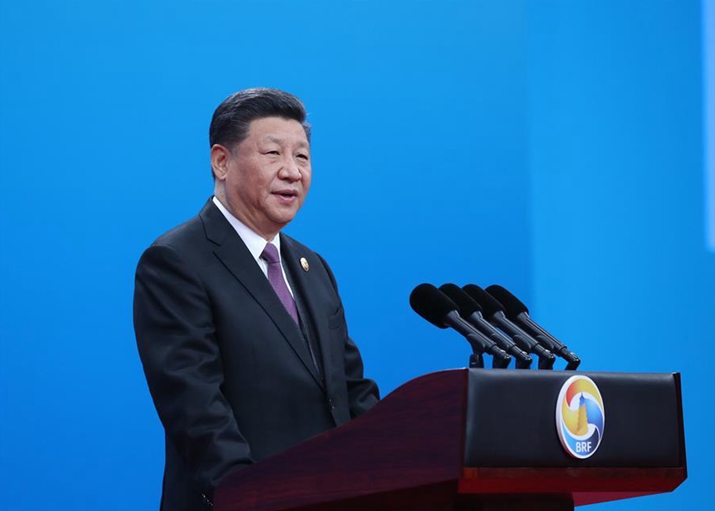最新权威发布
LATEST RELEASE业界资讯
NEWS重要概念范畴表述外译发布平台
PORTAL FOR MULTILINGUAL TRANSLATIONS OF KEY CONCEPTS, DEFINITIONS AND EXPRESSIONS中国关键词
KEYWORDS TO UNDERSTAND CHINA中国特色话语对外翻译标准化术语库
DATABASE FOR MULTILINGUAL TRANSLATIONS OF TYPICAL CHINESE TERMS AND EXPRESSIONS多语种党政文献简写本及专家解读文库
MULTILINGUAL DATABASE OF ESSENTIALS AND EXPERT COMMENTARIES ON CPC AND GOVERNMENT DOCUMENTS
编者按:2019年4月26日,国家主席习近平在北京出席第二届“一带一路”国际合作高峰论坛开幕式,并发表题为《齐心开创共建“一带一路”美好未来》的主旨演讲,强调共建“一带一路”不仅为世界各国发展提供了新机遇,也为中国开放发展开辟了新天地。以下是讲话的双语摘编:
目标与成果
共建“一带一路”倡议,目的是聚焦互联互通,深化务实合作,携手应对人类面临的各种风险挑战,实现互利共赢、共同发展。
在各方共同努力下,“六廊六路多国多港”的互联互通架构基本形成,一大批合作项目落地生根。
150多个国家和国际组织同中国签署共建“一带一路”合作协议。
共建“一带一路”为世界经济增长开辟了新空间,为国际贸易和投资搭建了新平台,为完善全球经济治理拓展了新实践,为增进各国民生福祉作出了新贡献。
增强互联互通
基础设施是互联互通的基石,也是许多国家发展面临的瓶颈。建设高质量、可持续、抗风险、价格合理、包容可及的基础设施,有利于各国充分发挥资源禀赋,更好融入全球供应链、产业链、价值链,实现联动发展。
我们欢迎多边和各国金融机构参与共建“一带一路”投融资,鼓励开展第三方市场合作,通过多方参与实现共同受益的目标。
我们要积极架设不同文明互学互鉴的桥梁,深入开展教育、科学、文化、体育、旅游、卫生、考古等各领域人文合作,加强议会、政党、民间组织往来,密切妇女、青年、残疾人等群体交流,形成多元互动的人文交流格局。
我们将持续实施“丝绸之路”中国政府奖学金项目,举办“一带一路”青年创意与遗产论坛、青年学生“汉语桥”夏令营等活动。
我们还将设立共建“一带一路”国际智库合作委员会、新闻合作联盟等机制,汇聚各方智慧和力量。
未来5年,中国将邀请共建“一带一路”国家的政党、智库、民间组织等1万名代表来华交流。
扩大改革开放
中国既是“世界工厂”,也是“世界市场”。中国有世界上规模最大、成长最快的中等收入群体。
为满足人民日益增长的物质文化生活需要,增加消费者选择和福利,我们将进一步降低关税水平,消除各种非关税壁垒,不断开大中国市场大门,欢迎来自世界各国的高质量产品。
我们不刻意追求贸易顺差,愿意进口更多国外有竞争力的优质农产品、制成品和服务,促进贸易平衡发展。
创新与知识产权保护
创新就是生产力,企业赖之以强,国家赖之以盛。我们要顺应第四次工业革命发展趋势,共同把握数字化、网络化、智能化发展机遇,共同探索新技术、新业态、新模式,探寻新的增长动能和发展路径,建设数字丝绸之路、创新丝绸之路。
中国将继续实施共建“一带一路”科技创新行动计划,同各方一道推进科技人文交流、共建联合实验室、科技园区合作、技术转移四大举措。
中国将着力营造尊重知识价值的营商环境,全面完善知识产权保护法律体系,大力强化执法,加强对外国知识产权人合法权益的保护,杜绝强制技术转让,完善商业秘密保护,依法严厉打击知识产权侵权行为。
Xi Jinping's Speech at the Opening Ceremony of the Second Belt and Road Forum for International Cooperation--Edited Excerpt

Editor's note: The Second Belt and Road Forum for International Cooperation was held in Beijing on April 26, 2019. Chinese President Xi Jinping addressed the opening ceremony. The following is an edited excerpt of his speech:
Goals and achievements
The Belt and Road Initiative aims to encourage connectivity among participating countries and deepen practical cooperation whilst working to tackle the key challenges that mankind presently faces. These goals are orchestrated so as to realize mutual benefits and shared developments between cooperative economies.
Under the joint efforts of all parties, a framework of "six corridors and six channels serving multiple countries and ports" has been formed and a large number of cooperation projects have landed.
So far more than 150 countries and international organizations have signed cooperation documents on the Belt and Road Initiative with China.
The development of the Belt and Road Initiative pioneered the opening of a new space for the world’s economic growth. The initiative has also created a platform to increase international trade and investment whilst making use of practices to enhance global economic governance in a way that improves people’s livelihoods throughout the world.
Encouraging connectivity
Infrastructure is the cornerstone of connectivity and a bottleneck of development confronting many countries. Building high-quality infrastructure that is sustainable, resilient, inclusive, accessible and reasonably priced could help countries give full play to their advantages in resources and better integrate into the global supply, industrial and value chains for interconnected development.
China encourages multilateral financial institutions and financial institutions from different countries to invest in and finance the Belt and Road Initiative, and will stimulate third-party market cooperation to achieve mutual benefits for the parties involved.
We need to promote cultural and social exchanges among the countries participating in the Belt and Road Initiative. To realize this objective, in-depth cooperation is called for in education, science, culture, sports, tourism, health care, archaeology amongst other areas. To form an interactive communication flow between various countries, the exchanges between parliaments, political parties, and NGOs should be reinforced, while more frequent communications between women, youth and the disabled should be strengthened.
We will continue to fund the Silk Road Chinese government scholarship program, and activities like the International Youth Forum on Creativity and Heritage and the Chinese Bridge Summer Camp will go on.
To stimulate the sharing of wisdom and power between contributing countries, China will develop new mechanisms to promote shared progress, such as the creation of a Belt and Road International Think Tank cooperation committee and a Belt and Road news network.
A total of 10,000 representatives of political parties, think tanks and NGOs from countries participating in the Belt and Road Initiative will be invited to China for exchanges in the next five years.
Reform and opening up
China has the world's biggest and fastest-growing middle-income group, and has earned its reputation as the "global market" and "global factory" of the world.
To meet the growing demand for material and cultural needs whilst increasing the options available for consumers, we need to reduce tariffs and remove non-tariff barriers, opening the Chinese market wider to the rest of the world and in turn to embrace high-quality goods imported from all over the world.
We do not seek trade surplus and will import more high-quality farm produce, manufactured goods and services in a bid to promote balanced trade.
Innovation and intellectual property rights protection
Innovation produces productivity, which makes companies competitive and countries prosperous. We need to keep up with the trend of the Fourth Industrial Revolution, jointly seizing opportunities created by digital, network and smart development, and exploring new technologies, new forms, and new models of development, so as to build a digital and innovative Silk Road by fostering new growth drivers and a new development pathways.
China will engage in innovation under the Belt and Road Initiative with all parties by pursuing four major initiatives, namely scientific and people-to-people exchanges, joint research labs, technology park cooperation and technology transfer.
The country will create a business environment that respects the value of knowledge, comprehensively improve the legal system for intellectual property rights (IPR) protection and intensify law enforcement. It will strengthen the protection of the legitimate rights and interests of foreign IPR proprietaries, eliminate forced technology transfer, improve trade secrets protection and crack down on IPR infringements according to the law.